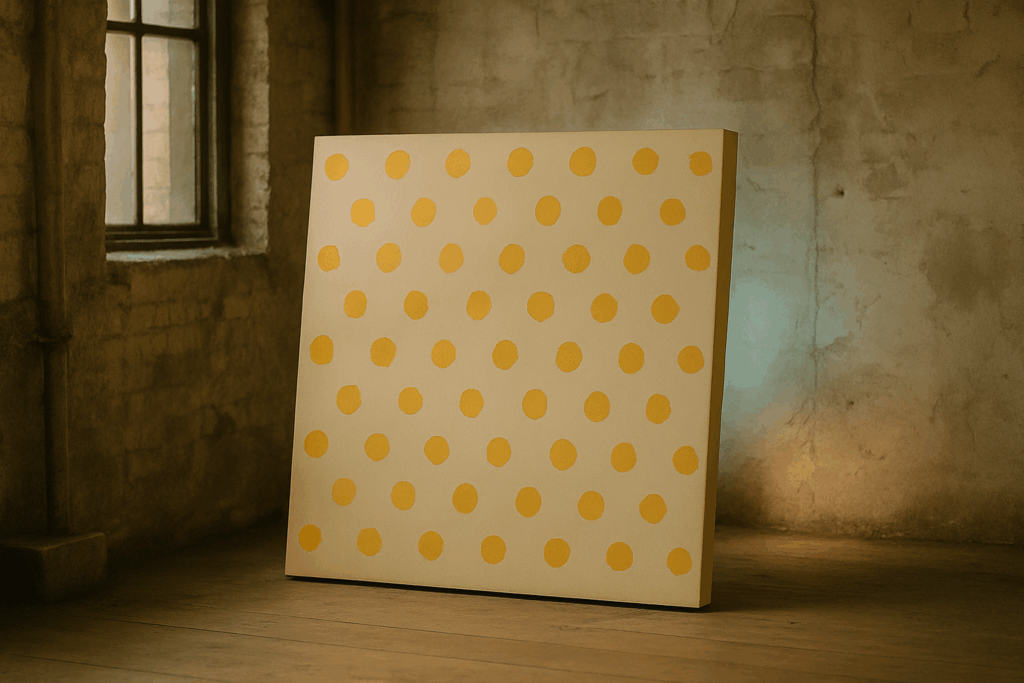Yayoi Kusama is one of the most recognizable and influential living artists in the world. Born in Japan in 1929, she’s spent decades blurring the lines between art, performance, and installation. Her work is obsessive, surreal, and deeply personal—rooted in hallucinations she began experiencing as a child. The repetition of dots, nets, and mirrored motifs became her way of processing an overwhelming inner world and making sense of the outer one.
Kusama’s influence on contemporary art is hard to overstate. She’s bridged pop art, minimalism, and conceptual art, long before those terms were in mainstream conversation. Her peers included Warhol and Judd, but she’s outlasted many of them in relevance. In recent years, younger generations have rediscovered her, especially through the lens of mental health, feminism, and outsider art. In that sense, her legacy isn’t just in museums—it’s in conversations around resilience and identity.
Then there are the Infinity Rooms. These immersive installations, box-shaped environments lined with mirrors and glowing lights, transform time and space. They don’t just hang on walls—they surround you, swallow you. They turn viewers into part of the work. In a digital age obsessed with glimpses and loops, Kusama’s rooms provide something rare: a moment of suspended clarity, even if it only lasts 30 seconds. That’s what makes them iconic—they’re both spectacle and meditation, hype and reflection, existing in sharp balance.
Yayoi Kusama didn’t arrive at infinity by accident. In the 1960s, she started experimenting with mirrors, lights, and repetition—trying to give physical shape to an inner world no one else could see. Her early Infinity Mirror Rooms weren’t just art objects. They were spaces you stepped into, designed to overwhelm sight, distort space, and—ideally—erase the boundaries of self. That was the point.
The impulse came from somewhere deeper. Kusama has long been open about her hallucinations—the intense visual patterns, glowing fields of dots, the way reality sometimes dissolves in her perception. Rather than hide from them, she channeled those visions into her work. Her installations, like her earlier net paintings and soft sculptures, became a way to wrestle with control, trauma, and the involuntary nature of her own mind.
The shift from canvas to full-space environments wasn’t just creative evolution—it was necessity. Paintings, for Kusama, couldn’t contain what she needed to say. The move into immersive installations was a logical step, rooted in the need to share her reality with others—not as metaphor, but almost as replication. She wasn’t just inviting people to view her work. She was asking them to step inside her psyche, even if only for a moment.
Why Infinity Rooms Still Resonate — Across Generations and Cultures
Yayoi Kusama’s Infinity Rooms have captivated audiences for decades, but their impact extends far beyond viral photos or fleeting gallery visits. These immersive spaces strike an emotional chord that transcends language, age, and background.
Shared Human Themes
Across generations and cultures, the Infinity Rooms tap into core aspects of the human experience:
- Connection to the cosmos: The mirror-lined rooms reflect infinite versions of the self, evoking awe, insignificance, and wonder all at once.
- Themes of repetition and obsession: These are central to Kusama’s work, echoing the repetitive patterns of mental illness, cultural ritual, and human behavior.
- Immersive stillness: In a frenetic world, standing alone in an Infinity Room can feel like entering a spiritual retreat.
The Rise of “Instagram Art”
With the boom of social media, immersive works like Kusama’s have often been labeled as “Instagram art”—highly photogenic, widely shared, and sometimes accused of prioritizing spectacle over substance.
A Double-Edged Phenomenon
- Blessing: Platforms like Instagram have helped bring contemporary art to wider audiences than ever before. Infinity Rooms, in particular, have become cultural entry points for many who may not otherwise visit galleries.
- Curse: On the flip side, the popularity of photo-driven experiences risks flattening rich, conceptual art into mere backdrops for likes. The pressure to create “shareable” art can overshadow deeper intentions.
Kusama’s Balancing Act: Spectacle Meets Sincerity
What makes Kusama’s work endure is not just its visual impact—but its emotional and philosophical depth.
- Her sincerity is rooted in personal history: From hallucinations as a child to lifelong struggles with mental illness, Kusama’s art is an extension of her psyche, not a marketing ploy.
- She embraces popularity but doesn’t pander: The rooms are undeniably spectacular—but they aren’t empty. Visitors often report feelings of disorientation, empathy, or transcendence.
- She defied commercialization before it was trendy: Long before art went viral, Kusama was rentlessly producing avant-garde work despite being overlooked by the art world for much of her early career.
In a time where authenticity can feel rare, Kusama’s Infinity Rooms remain powerful precisely because they are both visually arresting and emotionally authentic.
Step into any immersive mirror room, and you’re met with the same core elements: mirrors, LEDs, and a sense of visual infinity. It sounds simple. But what these elements do—when arranged just right—is far from basic. What starts as lights and reflections transforms into full-blown experiences: a corridor that stretches beyond sight, a chamber pulsing like a living, breathing organism, a space that folds you into itself.
Across installations, the emotional range is wide. Some rooms quiet your mind, with soft pacing and soothing color. Others completely disorient, flipping your sense of direction until left and right feel interchangeable. There’s awe too—the kind you feel when your own reflection disappears into an infinite grid and you forget where the walls end.
And while the ingredients might stay the same, the stories vary. One room might speak in slow pulses and warm tones, another in strobing cold blue light. These are visual languages crafted by artists to say things words can’t. Intimate yet expansive, fast or meditative—they’re all different ways of asking the same question: what do you feel when you’re surrounded by yourself forever?
Yayoi Kusama doesn’t stay within the lines—literally. Her work fuses sculpture, painting, fashion, and performance into a seamless expression of self. This isn’t art in a gallery box; it spills out into mirrored rooms, onto dresses, into films. She dissolves the borders between disciplines with the same intensity she applies dots to canvases—and the result is immersive, otherworldly, unmistakably hers.
At the core of this multimedia fusion is a loop of recurring themes: polka dots that swallow space and identity, a deep cosmic fascination, and the idea of self-obliteration. Her dots aren’t just decoration—they’re philosophical. When you’re inside one of her Infinity Rooms, you’re not sure where you end and the universe begins. That’s the point.
Her artistic voice also echoes across time. You can trace influences and overlaps with peers like Andy Warhol’s repetition, Yves Klein’s obsession with color, or even Joseph Beuys’ performative edge. But Kusama didn’t follow anyone—she pioneered, often in isolation and often ahead of the curve.
Kusama’s way of blending form, theme, and legacy sets her apart. She’s not just making art. She’s building an ongoing, living cosmos—one dot at a time.
(For more art evolution, check out: The Many Faces of Pablo Picasso’s Artistic Evolution)
Yayoi Kusama’s immersive art continues to pull global crowds, and it’s not slowing down. Major exhibitions in 2024 include headline shows at the Hirshhorn Museum in Washington, D.C., and a refreshed Infinity Mirror Room at Tate Modern in London. Meanwhile, permanent installations like the mirrored ‘Souls of Millions of Light Years Away’ at The Broad in Los Angeles offer deep, mind-bending experiences year-round. Japan’s Yayoi Kusama Museum in Tokyo remains a pilgrimage point for diehard fans, showcasing rotating exhibits in an intimate space that requires booking well in advance.
A word on logistics: timed entry is now standard, and these slots move fast—especially on weekends and holidays. Photography is usually permitted, but flashes and tripods are almost universally banned, so travel light. Expect lines even with a ticket, particularly for the most Instagrammed rooms. Your best bet to beat the crowd? Early weekday mornings, with a little patience in your pocket.
Beyond the big-name museums, institutions from Seoul to São Paulo are increasingly integrating Kusama’s work into contemporary art contexts. The global presence reflects not just enduring popularity, but support for her broader vision: connection through repetition, light, and reflection. It’s not just spectacle. It’s a growing legacy, grounded in both emotional honesty and calculated design.
In a digital age flooded with flash-in-the-pan content, Yayoi Kusama endures—not because she chases trends, but because she doesn’t. Her work resonates deeply in 2024, when people are more than ever drawn to experiences that feel real, textured, and emotionally charged. Kusama’s installations—dots, mirrors, pumpkins—aren’t just eye-catching; they’re immersive, meditative, and unashamedly human. They slow you down. They ask you to look longer.
What sets her apart is her refusal to flinch. Kusama lays herself bare through patterns, rituals, and obsessive repetition. It’s raw, but never sloppy. Her vulnerability is exacting, and that commitment radiates. Viewers aren’t just stepping into her work; they’re stepping into her psyche. In a world that often treats openness as weakness, Kusama turned hers into steel.
She reminds us that art doesn’t have to be loud to be powerful. It can be strange, soft, and meticulous. It can whisper and still echo. Kusama has always walked the line between solitary detail and cosmic vision—crafting something both quietly personal and infinitely shareable. In doing so, she’s not only made art for her time, but for all time.

 Johner Hazardics brought essential structural and technical support to FLP Emblemable, assisting in the development of its layout, functionality, and user-focused features. His dedication to smooth performance and intuitive design helped the platform grow into a reliable and engaging space for artists and enthusiasts alike.
Johner Hazardics brought essential structural and technical support to FLP Emblemable, assisting in the development of its layout, functionality, and user-focused features. His dedication to smooth performance and intuitive design helped the platform grow into a reliable and engaging space for artists and enthusiasts alike.